Tarihi çizimlere kayıtlı Ermeni Soykırımı hakikati

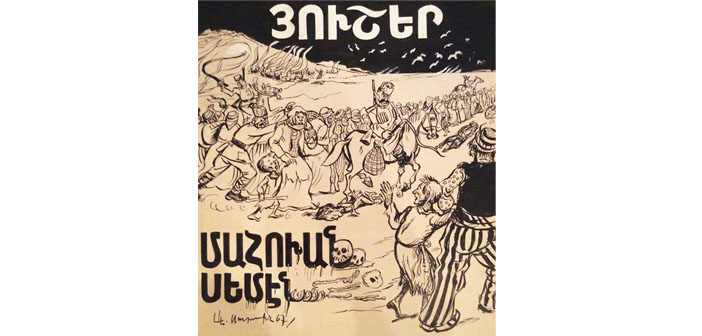
Kitabın yazarı: Vartevar Zeytuntsyan
Kitabın ismi: ‘Huşer, Mahvan Semen’ (Hatıralar, Ölümün Eşiğinde)
Alexander Saroukhan (1898 – 1977): Mısırlı Ermeni karikatürist Saroukhan, Batum’da (Rusya İmparatorluğu) doğdu. 1908’de ailesi ile İstanbul’a göç etti. Mkhitaryan Okulu’nda yatılı olarak okudu. Birinci Dünya Savaşı süresince, Saroukhan abisiyle birlikte okulda kapalı kaldı. Ancak savaşın sonunda dışarıya adım atabildiler. Alexander Saroukhan, 1922’de İstanbul’dan Belçika’ya kaçtı. Orada Viyana’ya gitti, ‘Graphic Lehr und Versuchsansalt’ okulunda grafik eğitimi aldı. 1924’te Mısır’a göç etti ve hayatının sonuna kadar orada yaşadı. Saroukhan, dünyanın en iyi ve en tanınmış çizerleri arasında yer alıyor. Karikatürleri, birçok Arap ve uluslar arası dergilerde ve gazetelerde yayımlanmıştır.
Fotoğrafçılık, basılı yayında kendine yer bulmadan ve foto muhabirliği terimi ortaya çıkmadan önce, ahşap oyma baskı yapılırdı. Ahşap oyma sanatı, illüstrasyon ve karikatür yaratarak doğrudan veya dolaylı yoldan fotoğrafın işlevini görürdü. Bu meslek ve sanat sayesinde insanlık, dünyanın farklı köşelerinde olan bitenlerden, olaylardan, felaketlerden, savaşlardan haberdar olur; aynı zamanda tanımadığı, bilmediği diğer kıtaları, ülkeleri, ulusları ve kültürleri tanırdı.
Görgü tanıkları ve tarihçiler gibi, illüstratörler ve karikatürist-ressamlar da güvenilir kaynaklardan aldıkları bilgileri basılı yayına aktardı. Böylece oryantalistlerin doğuya yaptıkları seyahatleri betimlemeleri gibi, okuyucunun bu özgün çizimlerle konuya daha hâkim olmalarını sağladılar.
Çizgilerle 1915
Osmanlı İmparatorluğu’nun ‘hasta’ olarak tanımlandığı dönemde, Jön Türkler ve ardından da İttihat ve Terakki Partisi döneminde planlanmış ve gerçekleştirilmiş Ermenilerin imhasını betimleyen çizimler ve karikatürlerin yayınlandığı uluslararası basının örnekleri oldukça fazladır. Özellikle günümüzde kitle iletişim araçlarının haber ve her türlü bilgiyi yaygınlaştırma olanakları göz önünde bulundurulduğunda, söz konusu görsel malzemenin o dönem için belge anlamında taşıdığı önem, daha iyi anlaşılır.
İnkârcı kalemler uluslar arası basında çıkan karikatür ve illüstrasyonları, Ermenilerin lobicilik faaliyetleri ile açıklamaya çalışıyorlar ancak bu çizimlerin basında yer aldığı yıllarda henüz bir ‘Ermeni lobisi’ oluşturulmamıştı. O dönemde, soykırım mağduru Ermeniler, Der Zor çöllerinde ölüm kalım mücadelesi vermekteydi. Ayrıca, Ermenilerin ‘lobi’ faaliyetleri, ancak 20. yüzyılın ikinci yarısından sonra, yani yaşama yeniden tutunmayı başardıkları ve halkın insani, kültürel ve manevi kayıplarını telafi etmeye başladığı dönemlere rastlar.
Yabancı yayınlarda yer alan bu ‘provokatif’ resimlerin bizzat o ülkelerin yönetimlerince Ermenilerin yararına sipariş edildiği de söylenir. Gel gör ki Ermenilerin; Batı’nın İngiltere, Almanya, Fransa, Belçika gibi güçlü ülkelerini yönlendirebilecek imkânının olmayışı bir yana, bu ülkeler 17. yüzyıl Japonyası’nda Tōshō-gū kapısına nakşedilen ‘Mizaru, Kikazaru, Iwazaru’ adıyla bilinen görmeyen, işitmeyen, konuşmayan üç maymun rolündeydiler.
Rüzgârın hafızası
19. yüzyılın ortalarında, gazeteler ve onlara paralel olarak siyasi mizah büyük bir ivme kazanmışken, Avrupa ülkelerinden hemen sonra Ermeni ustalar sayesinde İstanbul’da da resimli gazetecilik ve siyasi mizah, toplumu bilinçlendirmek doğrultusunda çok önemli mesafeler katetmişti. O dönemin resimli gazetecilik, grafik gazeteciliği, siyasi mizah ve karikatürleri, günümüzün fotoğraf gazeteciliğini temsil ediyorlar ve medyanın en önemli yeniliği sayılıyorlardı.
Bu sayfada söz konusu basından yaptığımız küçük bir derlemeyi dikkatinize sunuyoruz. Punch (İngiltere), Simplicissium (Almanya), Chicago Daily News (ABD), Khatapala (Gürcistan) gazetelerinin sayfalarında; Oskar Shmerling, Thomas Theodore Heine, Luther Daniels Bradley, Oliver Herford, Bernard Partridge, Alexander Saroukhan gibi tanınmış ve okurun güvenini kazanmış çizerlerin belge niteliğindeki çizimleri bulunuyor.
İnsanoğlu konuşmayı öğrenmeden, henüz harfleri keşfetmeden ve yazılı ifadelere geçmeden önce mağara duvarlarına yaptığı çizimlerle çevresinde olup bitenleri kayıt altına alarak sonraki nesillere aktardı. Günümüzden kırk bin yıl önce yapılan mağara resimleri, insanlığa, o döneme dair yaşam izleri ile ilgili önemli ipuçları verdi. Yüz yıl önce yaşanan felaketin ortasında ve tam da o yıllarda çizgiyle ifade edilenlerde de hakikat saklı.
Kumun hafızası yoktur denir.
Kuma çizilen çizgi rüzgârla yok olur.
Oysa rüzgârın hafızası vardır.
Der Zor çölünün yakıcı rüzgârı tanık buna.
Mağara döneminden günümüze kadar çizgi, kod olma özelliğini koruyor. Evrensel bir kodlama bu. Hepimizin en iyi anlayabildiği iletişim aracı. Ne de olsa hepimiz, kendimizi ilk olarak çizgilerle ifade etmeye başladık. Gelin çizgilerin arasında örtülmüş, gömülmüş çizgileri arayalım, nesneleri kendi isimleri ile tanıyalım, altını çizelim.
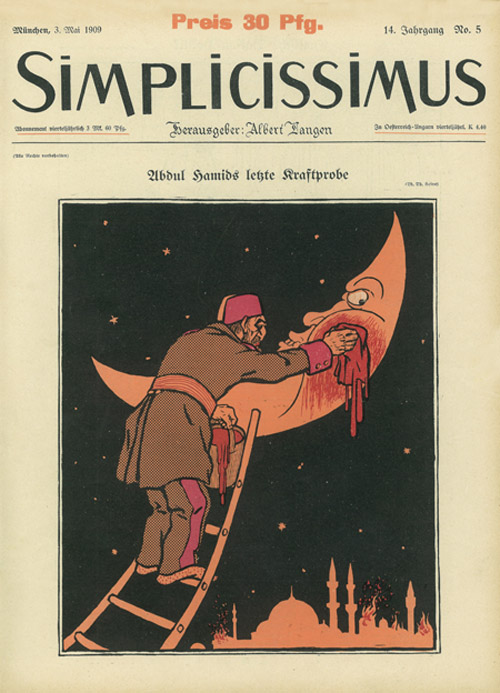
Dergi: Simplicissimus 1909 - Münih
Başlık: “Abdülhamit’in son sınavı”Sanatçı: Thomas Theodore Heine
Simplicissimus: Albert Langen tarafından 1896’da kurulan ve 1944-1954 yıllarında verdiği arayla birlikte 1967’ye kadar yayın yapan haftalık bir Alman hiciv dergisi.
Thomas Theodore Heine (1867-1948): Alman ressam ve çizer. Leipzig’de doğan Heine, genç yaşta yetenekli bir çizer olarak tanındı. Düsseldorf ve Münih’teki sanat akademilerinde eğitim aldı. 1896’da Simplicissimus’ta çizmeye başladı. Toplumsal düzen ve özellikle de monarşiye yönelik eleştirel çizimleri yüzünden 1898’de altı ay hapis yattı. 1890’larda kitaplar için çizim yapmaya başladı. 1933’te Almanya’dan kaçarak Prag’a gitti. 1942’den ölümüne kadar Stockholm’de yaşadı. (Yerevan’da bulunan Ermeni Soykırım Müzesi ve Enstitüsü koleksiyonundan.)
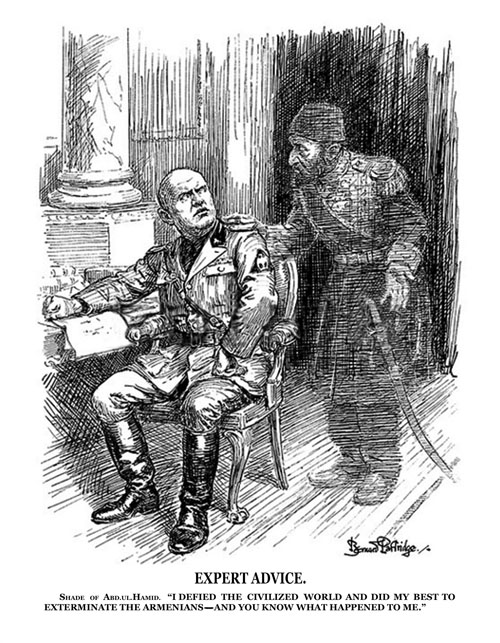
Dergi: Punch - 1936 - Birleşik Krallık
Başlık: “Uzman Tavsiyesi”“Abdülhamit’in gölgesi. ‘Modern dünyaya meydan okudum ve Ermenileri yok etmek için elimden geleni yaptım. Başıma ne geldiğini biliyorsun.’ ”Sanatçı: Bernard Partridge
Punch: 1841’de Henry Mayhew ve Ebenezer Landells tarafından kurulan İngiliz mizah ve hiciv dergisi. 1840’lar ve 1850’ler, en etkili olduğu dönemdi; mizahi çizim anlamında kullanılan ‘cartoon’ kelimesinin türetilmesine katkı sağladı.1940’lardan sonra tirajı zirveye çıktı. Yıllar sonra bir gerileme dönemine girerek 1992’de kapandı. 1996’da tekrar yayın hayatında başladıysa da 2002’de yayım hayatını sonlandırdı.
Bernard Partridge (1861-1945): Londra’da doğdu. ‘Royal College of Surgeons’un başkanı Prof. Richard Partridge’in oğlu ve Kraliçe Victoria’nın portresini çizen John Partridge’in yeğeni. Kitap illüstrasyonları ile ünlendi. 1891’de Punch’ta çizmeye başladı. 1910’da derginin baş karikatüristi oldu.
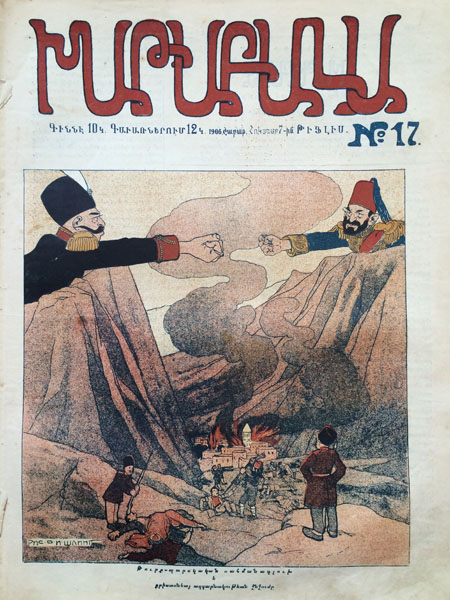
Dergi: Khatapala 1906 - Tiflis
Başlık: “Türkiye-İran arasında, Hıristiyan nüfusun yok oluşu”Sanatçı: Oskar Shmerling

Başlık: “Yeni bir sayfa açmak” 1916
Sanatçı: Oliver Herford
Oliver Herford (1863-1935): Amerikalı yazar, ressam ve çizer. ‘The Mentor’ (Akıl hocası), ‘Life’ (Hayat) ve ‘Ladies’ Home Journal’a (Kadınların ev dergisi) yazılar yazdı. 1906’da ‘Little Book of Bores’ (Sıkıntıların küçük kitabı) kitabını yazdı ve resimledi. Kısa şiirleri vardır. Kardeşi Beatrice Herford da mizahçıdır.
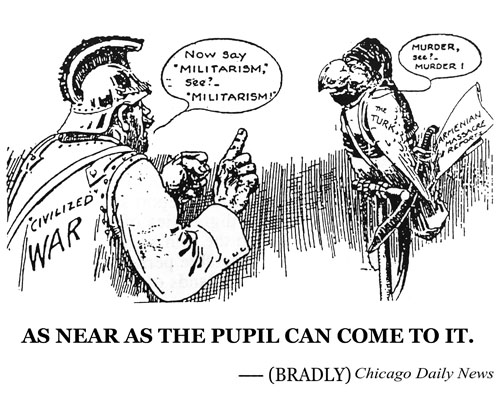
Dergi: Chicago Daily News - ABD
Başlık: “Çırak ne kadar olabilirse”Sanatçı: Luther Daniels Bradley
Chicago Daily News: Chicago’da yayımlanan günlük akşam gazetesi. 1876-1978 yılları arasında yayımlandı.
Luther Daniels Bradley (1853-1917): Chicago Daily News’un çizeri. Çocuk kitapları yazıp resimledi. Kariyerinin erken dönemlerinde mizah dergisi ‘The Melbourne Punch’ta çizdi.
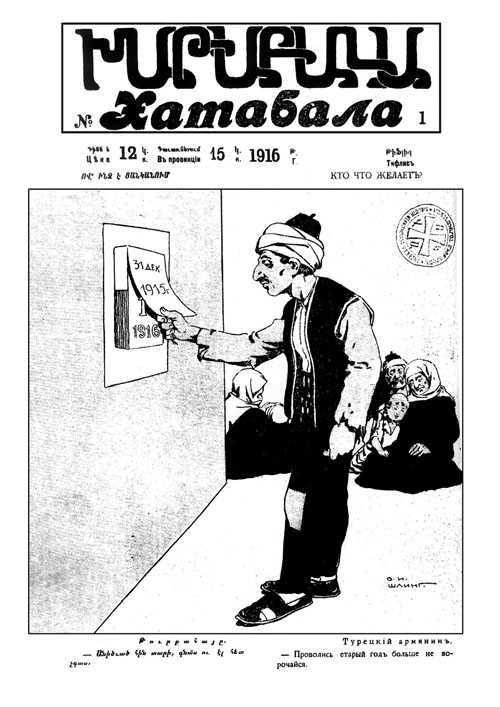
Dergi: Khatapala - 1916 - Tiflis
Başlık: “Kim ne istiyor?”“Türkiyeli Ermeni: Lanetlenmiş yıl; gidesin ve bir daha gelmeyesin.”Sanatçı: Oskar Schmerling
Khatapala: Haftalık renkli mizah ve hiciv dergisi. Tiflis’te 1906-1916, 1922, 1925-1926 tarihleri arasında yayımlandı. Yayıncılığını Asdvadzadur Yeritsyan’ın, editörlüğünü Aşod Atanasyan’ın yaptığı Khatapala, Osmanlı’nın Ermenilere uyguladığı katliamları ele aldı. Transkafkasya halklarının dostluğunu savundu. Uluslararası gelişmelerden, Balkan ve Doğu halklarının özgürlük mücadelesinden haberler yayımladı. Fıkralara ve bulmacalara yer verdi. 1922’de tek sayı, 1925’te beş, 1926’da iki sayı yayımlandı. (Khatapala ile ilgili bilgi: Zakarya Mildanoğlu’nun yazdığı ‘Ermenice Süreli Yayınlar 1794-2000’ adlı kitaptan)
Oscar Shmerling (1863-1938): Tiflis’de doğdu. 1884-1891 yılları arasında St. Petersburg Sanat Akademisi’nde okudu. 1891 yılında gittiği Münih’ten 1893’te döndü. 1918’e kadar Tiflis’teki ‘Resim ve Heykel Akademisi’nin yöneticiliğini yaptı. Shmerling, Gürcü karikatür sanatının kurucusu sayılır. Karikatürleri, 1901’den itibaren birçok Kafkasya dergi ve gazetesinde yayımlanmaya başladı. Khatapala, Tartarus gibi dergilerle işbirliği yaptı.


